By Jacqueline Simoneau
Getting your hands dirty can be a great workout, benefiting both body and mind; here’s how to dive into gardening season without risking aches and injuries
Twenty years ago, Anick bought her first house. “I knew nothing about gardening,” she recalls. “I began by planting a few shrubs, and then I made some flowerbeds. I really got into it. Gardening helped me get back in shape, as I’m a bit of a couch potato in the winter. By the end of the summer, I was more flexible and had more stamina.”
Louis Lévesque, 70, is another gardening buff. “When I’ve got my hands in the soil, I forget about everything, including my aches and pains,” he says. “It also makes me move more, which helps me maintain a good level of mobility.”
No surprise there. Digging, raking, sowing, planting, weeding, carrying loads, mowing, and pruning are strenuous enough that gardening is almost a sport. Studies show that it’s comparable to a low- to moderate-intensity workout. It can even burn up to 300 calories an hour.
Recognized Benefits
According to Dr. Luc De Garie, a sports medicine specialist, the various tasks related to gardening have the advantage of getting all the muscles and joints working together, including those we don’t use as much day to day. And doing these regular and repeated movements, working the muscles and joints, has significant physical benefits.
“Gardening improves flexibility, increases stamina and muscle strength, promotes dexterity, helps with mobility, and develops balance,” says physiotherapist Édith Castonguay. “And by strengthening the bones, gardening reduces the risk for osteoporosis. It’s also good for the cardiovascular system. And getting some sun helps you fill up on vitamin D.”
Start Slowly
In the spring, it’s easy to dive into gardening forgetting that certain muscles haven’t been used over the winter. The result is a sore back, muscle strain, and knee pain that can really spoil the fun. It’s best to start with short sessions and gradually extend the time so your body can adjust to the new workload. Go step by step, starting with easier jobs.
To reduce the chance of injury, you need to warm up your muscles and joints at the beginning of each gardening session, such as by doing a few stretches—arching your back, rolling your shoulders, wrists, and ankles, nodding and shaking your head, and extending your arms. Walking for five to 10 minutes is also recommended before tackling gardening tasks. It’s important to stretch well at the end of the day, too.
Garden Safely
Improper posture and techniques can cause a lot of trouble for gardeners. So can the wrong equipment. To lift an object or put one down, Castonguay suggests squatting, engaging your leg muscles: stand with your feet apart, and bend your knees while keeping your back straight. “It’s also important to hold the load close to your body,” she says. “If needed, divide a large load into a few smaller ones.”
For ground-level tasks, avoid working at arm’s length or leaning forward. According to De Garie, it’s better to crouch with one knee on the ground or to kneel. You can also use a practical small gardening bench to protect the lumbar spine and knees. Avoid stretching and twisting movements: It’s better to pivot the whole body in place than to turn the torso. This is true when you’re shovelling earth, too.
To rake without causing stress to your body, it’s recommended that you place one leg forward and the other back, changing the position of your legs and your hands from time to time.
Don’t forget to switch to a different task every 30 minutes or so, going from a more difficult one to an easier one or from kneeling to standing so you avoid using the same muscles and joints for a long time.
Finally, use the right tools. They should be light, have a padded, non-slip handle so you can get a good grip, be the right height so you don’t have to bend too much, and be suited to the task. Before buying tools, be sure to try them, mimicking real working positions.
Horticultural Therapy
Horticultural therapy is a recognized practice used to promote well-being and healing, often among those who have depression, and your time in the garden can give you the same amply proven benefits. “Gardening is a recognized anti-stress activity,” says psychologist Gaétan Roussy. “It allows you to release stress, empty your mind, and unwind.
But there’s more. Gardening has been found to improve cognitive abilities by stimulating the brain. It increases concentration: you have to pay attention to what you’re doing. It also develops creativity, spatial awareness, and coordination—for example, in the way you plan and organize flowerbeds or a vegetable garden. Plus, it’s very gratifying. Seeing the progress of the work you’ve done boosts morale and self-esteem. In addition, gardening helps to build social connections by fostering conversations with others as you share tips and advice and help friends, neighbours, and other gardening enthusiasts.” It’s a win-win!






